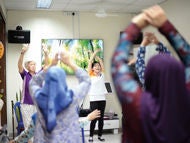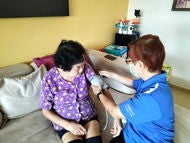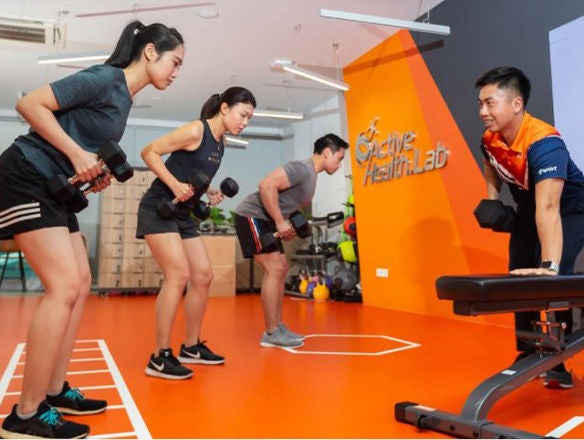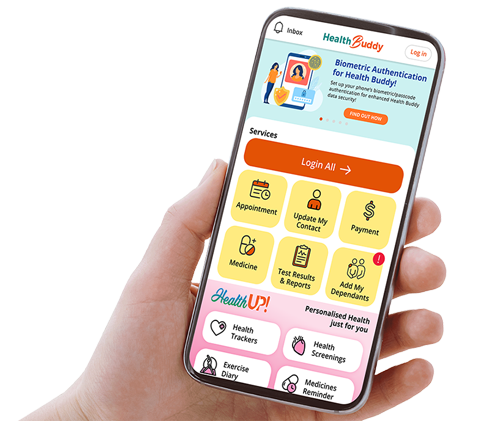.png) Clinicians at the workshop, including Dr Srujana Vedicherla (2nd from left) and A/Prof Seow Wan Tew (3rd from left)
Clinicians at the workshop, including Dr Srujana Vedicherla (2nd from left) and A/Prof Seow Wan Tew (3rd from left)
Chin chow is known for its 'cooling' properties but now neurosurgeons are using the herbal jelly to help trainees learn how to perform complex procedures.
Chin Chow, or grass jelly as it is also known, is often eaten as a dessert or added to bubble tea, but now it has a new use beyond tickling the tastebuds. The humble herbal jelly played a starring role at a hands-on workshop on keyhole brain surgery, organised by NNI's Department of Neurosurgery in Dec 2024.
Keyhole (endoscopic) surgery allows neurosurgeons to operate deep within the brain without removing a large piece of skull. It involves inserting a neuroendoscope – a long, thin metal instrument, with a light and camera on the end – into the brain. The camera sends images to a screen, allowing the neurosurgeon to see inside the brain, locate the problem area and perform procedures using miniature tools that is passed through the neuroendoscope.
Keyhole brain surgery is often used to manage conditions that affect the ventricles – these are hollow structures in the middle of the brain where cerebral spinal fluid (CSF) is produced. CSF cushions the brain and removes waste products from cells.
“Brain tumours and blood clots inside the ventricles and structural congenital anomalies can block the flow of CSF leading to a build-up of fluid in the brain (hydrocephalus). These conditions are more common in children, and keyhole surgery is often used to divert CSF flow to treat hydrocephalus, and to biopsy and remove these tumours; it can also be used for similar conditions in adults,” says Associate Professor Seow Wan Tew, Senior Consultant, Neurosurgery, who organised the Neuroendoscopy Hands-on workshop for Neurosurgery Residents on 28 December 2024.
Learning to navigate using the endoscope and manoeuvre safely within the brain is challenging due to the soft brain tissue which damages easily, hence the need for these types of hands-on workshops. Removing blood clots from the brain and ventricles using the endoscope is one of these manoeuvres that trainee neurosurgeons should master. So Assoc Prof Seow looked for ways to enable junior doctors to practise using the equipment with zero risk to patients.
He found the answer at the supermarket.
"Grass jelly’s soft texture has a similar consistency to blood clots caused by bleeding in the brain, while instant mashed potato is soft and smooth like the brain and able to hold the grass jelly 'blood clots' in place. This makes an ideal combination for a model of intracerebral hematoma for junior doctors to practise on, so they can get familiar with using the instruments and navigating with an endoscope, and removing the clot," explains Assoc Prof Seow.
A/Prof Seow learnt about this model from Prof Hisayuki Murai, a neurosurgeon from Japan. Prof Murai would prepare “coffee jelly” from ingredients from Japan for such workshops, including one which was organised by A/Prof Seow during the International Federation of Neuroendoscopy (IFNE) Congress in December 2023.
For the NNI workshop, urine specimen bottles were filled with mashed potato with grass jelly buried inside. The bottle was placed in a plastic skull and covered. The trainee inserted a round plastic sheath (Brainpath) through a hole at the top, through the mash potato, into the jelly, then passed the neuroendoscope into the sheath, using images from the camera to identify the grass jelly blood clots. A suction tool was then passed down the sheath to remove the 'clot'.
Urine specimen bottles filled with mashed potato with grass jelly buried inside
Using urine specimen bottles meant the contents could be prepared in advance then quickly swapped over during the workshop so each participant had a fresh sample to work on.
Other food items were also used during the workshop to simulate other neuroendoscopic procedures. For example, the trainees practised taking biopsies using forceps and microscissors from suspended grapes and chicken balls, to gain experience using the instruments with different ‘textures.’
.png) Urine specimen bottles filled with mashed potato with grass jelly buried inside
Urine specimen bottles filled with mashed potato with grass jelly buried inside
How did trainees find the workshop?
“Neuroendoscopy is an important skill to learn, but opportunities are limited during residency training due to the limited number of cases and needing to be in the right place at the right time. So, I was thrilled when Prof Seow, an authority in the field, suggested an introductory programme for residents,” says Dr Srujana Vedicherla, Chief Resident, Neurosurgery.
“When packed into the mashed potato, the chin chow really is close to a haematoma (blood clot) in terms of the handling, appearance and texture – even the sound and feel of it coming up the sucker is similar to a haematoma coming up the sucker tubing in the operating theatre!”
With the amount of brain tissue and blood neurosurgery trainees encounter regularly, it is perhaps not surprising that Dr Vedicherla continues to enjoy eating chin chow.
We hope this article hasn’t put you off eating it too!
Keep Healthy With
© 2025 SingHealth Group. All Rights Reserved.



















